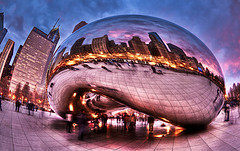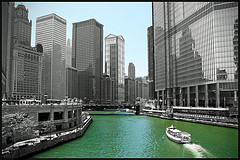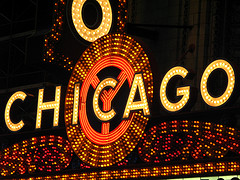4. Chicano Literature
Chicano literature is the literature written by Mexican Americans in the United States. Although its origins can be traced back to the sixteenth century, the bulk of Chicano literature dates from after 1848, when the USA annexed large parts of what had been Mexico in the wake of the Mexican-American War.
Chicago is the setting of the novel 'The House on Mango Street', written by the Mexican American author Sandra Cisneros. Sandra Cisneros was born in Chicago in 1954, to a Mexican father and a Chicana mother. She moved frequently during her childhood and visited Mexico often, to visit her paternal grandmother. Like Esperanza, the main character in The House on Mango Street, Cisneros recalls these moves as painful experiences: "'Because we moved so much, and always in neighborhoods that appeared like France after World War II--empty lots and burned-out-buildings--I retreated inside myself'". The experience of recognizing her difference from other students at the University of Iowa eventually led to the writing of The House on Mango Street, which was published in 1984 and won the Before Columbus Foundation's American Book Award in in 1985. Returning to Chicago after graduate school, Cisneros worked various jobs that engaged with the Chicano community, including teaching high school drop outs. She now resides in San Antonio, Texas. Learn more about Sandra Cisneros here.
Adapted from: http://www.english.illinois.edu/maps/poets/a_f/cisneros/bio.htm
 Imagen de JH Images.co.uk en Flickr bajo licencia CC |
|
 Imagen de Chris Smith en Flickr bajo licencia CC |
 Imagen de Bert Kaufmann en Flickr bajo licencia CC |
Chicago is the third most populous city in the United States, after New York City and Los Angeles. With 2.7 million residents, it is the most populous city in both the U.S. state of Illinois and the American Midwest. Its metropolitan area, sometimes called Chicagoland, is home to 9.5 million people and is the third-largest in the United States.
The demographics of the city are as follows:
Chicago has a Hispanic or Latino population of 28.9% (21.4% Mexican, 3.8% Puerto Rican, 0.7% Guatemalan, 0.6% Ecuadorian, 0.3% Cuban, 0.3% Colombian, 0.2% Honduran, 0.2% Salvadoran, 0.2% Peruvian)
Source: http://en.wikipedia.org/wiki/Chicago
Visit Chicago virtually here.
'The House on Mango Street' is a novel written in vignettes.
Read part of the first vignette. Then do the activity below.
"We didn't always live on Mango Street. Before that we lived on Loomis on the third floor, and before that we lived on Keeler. Before Keeler it was Paulina, and before that I can't remember. But what I remember most is moving a lot. Each time it seemed there'd be one more of us. By the time we got to Mango Street we were six—Mama, Papa, Carlos, Kiki, my sister Nenny and me.
The house on Mango Street is ours, and we don't have to pay rent to anybody, or share the yard with the people downstairs, or be careful not to make too much noise, and there isn't a landlord banging on the ceiling with a broom. But even so, it's not the house we'd thought we'd get.
We had to leave the flat on Loomis quick. The water pipes broke and the landlord wouldn't fix them because the house was too old. We had to leave fast. We were using the washroom next door and carrying water over in empty milk gallons. That's why Mama and Papa looked for a house, and that's why we moved into the house on Mango Street, far away, on the other side of town.
They always told us that one day we would move into a house, a real house that would be ours for always so we wouldn't have to move each year. And our house would have running water and pipes that worked. And inside it would have real stairs, not hallway stairs, but stairs inside like the houses on TV. And we'd have a basement and at least three washrooms so when we took a bath we wouldn't have to tell everybody. Our house would be white with trees around it, a great big yard and grass growing without a fence. This was the house Papa talked about when he held a lottery ticket and this was the house Mama dreamed up in the stories she told us before we went to bed.
But the house on Mango Street is not the way they told it at all. It's small and red with tight steps in front and windows so small you'd think they were holding their breath. Bricks are crumbling in places, and the front door is so swollen you have to push hard to get in. There is no front yard, only four little elms the city planted by the curb. Out back is a small garage for the car we don't own yet and a small yard that looks smaller between the two buildings on either side. There are stairs in our house, but they're ordinary hallway stairs, and the house has only one washroom. Everybody has to share a bedroom—Mama and Papa, Carlos and Kiki, me and Nenny.
|
Imagen de Haakon von Martinsky en Flickr bajo licencia CC |
 Imagen de Marc Wathieu en Flickr bajo licencia CC Imagen de Marc Wathieu en Flickr bajo licencia CC |
The excerpt from 'The House of Mango Street' describes a dream house and a real home where Esperanza, the main character in the novel, and her family live. You are now going to describe your dream home and your real home to your partner. In order to do that you will have to compare and contrast the two homes. You can use some of the following words and expressions:
- Similarly
- As well as
- In the same way
- On the contrary
- However
- Whereas, etc
Take some brief notes before you start your conversation. Remember you cannot read directly from them. Talk for 5 minutes.

